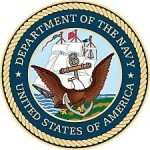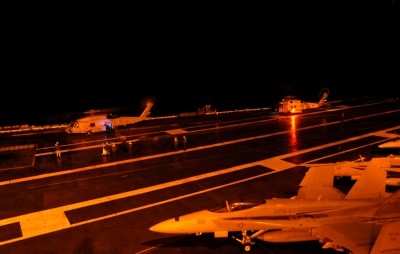Aircraft Carrier Was Headed For The Mid-East, Helps Out Coast
Guard
 Only hours after departing for its
2010 deployment, Nimitz-class aircraft carrier USS Dwight D.
Eisenhower (CVN 69) diverted from flight operations to assist the
U.S. Coast Guard in a rescue at sea the night of January 2, saving
the life of a stranded mariner.
Only hours after departing for its
2010 deployment, Nimitz-class aircraft carrier USS Dwight D.
Eisenhower (CVN 69) diverted from flight operations to assist the
U.S. Coast Guard in a rescue at sea the night of January 2, saving
the life of a stranded mariner.
Responding to a vessel-in-distress call, the U.S. Coast Guard
requested Eisenhower's aid in the successful extraction of a man
whose sailboat had capsized in rough waters approximately 300 miles
off Cape Hatteras, N.C. Eisenhower immediately changed course and
sailed at high speed toward the distressed mariner.
Initially, a Coast Guard Helicopter planned to only land on
board Eisenhower to refuel before proceeding to the scene, but more
immediate action became necessary when news came that the boat's
main mast had broken and was taking on water, explained Lt. j.g.
Randolph Moyer, one of Eisenhower's tactical action officers.
The U.S. Coast Guard and the U.S. 2nd Fleet Maritime Operations
Center coordinated to identify the Eisenhower and its air assets as
the quickest and safest way to rescue the mariner.
The "Nightdippers" of Helicopter Anti-Submarine Squadron (HS) 5,
launched a search and rescue (SAR) team to extract the mariner from
18 to 21 foot seas and winds peaking at 45 knots.
A Coast Guard C-130 dropped two life rafts for the mariner after
the waves destroyed the sailboat's mast. The mariner abandoned his
sinking boat and struggled for nearly an hour in the high seas to
reach one of the life rafts. The Coast Guard airplane offered
aerial support by directing the SAR helicopter through both snow
and rain to the life raft.
Lt. Cdmr. Scott Pichette, the helicopter aircraft commander,
said the experience and professionalism of the crew made it
possible to complete the challenging mission. "Most of us have been
in for almost 18 years, and those were some of the biggest waves
any of us had seen," Pichette said. "Mother Nature threw bad
weather, ice, snow and hail making it a stretch for us and the
helicopter."

Naval Air Crewman 1st Class David Brandon, the SAR crew chief,
said the rescue swimmer, Naval Air Crewman 2nd Class Kyle Need,
completed the extraction in only six minutes in spite of the
intense conditions.
Need said it was the collective effort that made the extraction
possible. "We went over every possible scenario during the transit.
The communication made the mission go smoothly," he said.
The copilot for the SAR mission, Cmdr. Byron Ogden, explained
that while the conditions were treacherous, the cooperation between
the SAR team and the Coast Guard made the mission a success. "This
is honestly one of the most varsity things we could do as far as
SAR goes," said Ogden, "I didn't hear one bit of panic in anybody's
voice; the whole crew was very calm, cool and collected."

The mariner was treated briefly aboard Eisenhower before being
transferred to a Coast Guard helicopter and flown to an Elizabeth
City medical facility.
According to Brandon, even after the ordeal, the mariner was in
good spirits and grateful to have survived. "With those conditions,
he was lucky he made it."
ANN Salutes Mass Communication Specialist 3rd Class Christopher
A. Baker, USS Dwight D. Eisenhower Public Affairs.
 NTSB Prelim: Lee Aviation LLC JA30 SuperStol
NTSB Prelim: Lee Aviation LLC JA30 SuperStol Classic Aero-TV: Curtiss Jenny Build Wows AirVenture Crowds
Classic Aero-TV: Curtiss Jenny Build Wows AirVenture Crowds ANN's Daily Aero-Term (05.30.25): Very High Frequency (VHF)
ANN's Daily Aero-Term (05.30.25): Very High Frequency (VHF) Aero-News: Quote of the Day (05.30.25)
Aero-News: Quote of the Day (05.30.25) Classic Aero-TV: Quest Kodiak Enhances Migration Monitoring Programs
Classic Aero-TV: Quest Kodiak Enhances Migration Monitoring Programs





